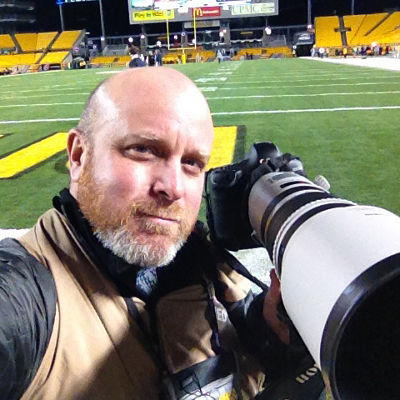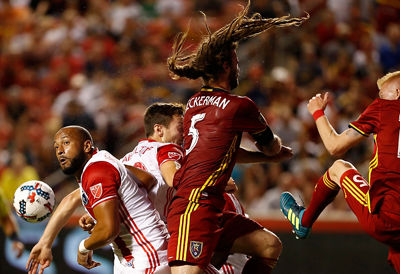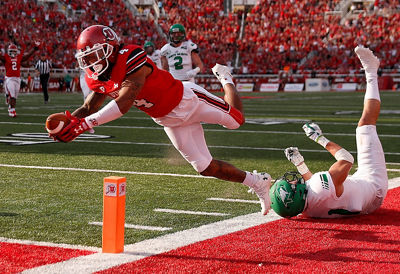When I was a young athlete, there was nothing more exciting than playing under the lights. It was not the norm to have lighted fields or stadiums, so it was truly a special occasion and a real rush when those lights kicked on. It really felt like the focus was on us under those giant spots. The sound of the announcer echoed from the press box on top of the stands, and you could hear the fans more than you could see them due to the shadows.
Even after all these years, there is still something special about Friday night lights. So many things that come to mind: the strains of the marching band, cheerleaders preparing, the smell of hotdogs on the grill. It’s funny how so many sounds and smells trigger my visual memory. It can be so rewarding to shoot under the lights despite the challenges that come with it.

Night Sports = Low Light Levels
Little did I know that years later, the glow of those bright lights wasn't so bright after all. It wasn’t until my first assignment shooting Friday night football that I realized it was really dark. When I put my camera up to my eye and metered the situation, I found I was stumped. I didn’t have the fastest of lenses and the luxury of using an ISO of 10,000 like with modern digital cameras. I was lucky to have anywhere from 800 ISO to 3200 ISO. I tried many combinations of film speeds and pushing the ISO on a roll of film to a higher ISO. You could essentially fool the camera and film by using different chemicals and temperatures in the darkroom. This allowed us to have a little extra latitude in raising ISOs. There also were many times where I used on-camera flash to light my subjects. I did this for a long time and tried several different systems to get the flash as far from my lens as possible, such as flash brackets generally used by wedding photographers. But using long lenses and on-camera flash always created red eye in my photos. Even in black and white, the eyes glow and look totally unnatural. So between pushing film in the darkroom and using strobes, I was able to shoot football under the lights, although it was not ideal.

Camera technology has really grown by leaps and bounds since the days of film, darkrooms and chemicals. Now we can shoot under the lights with just about any camera Canon makes. We don’t even need the super-fast long 2.8mm lenses to do it. With the advancements in sensors, we can shoot under the light in most stadiums and arenas with most kit lenses and cameras.
The beauty of shooting youth or high school sports is the ease of access. Once access is secured and you're able to hit the sidelines to take pictures, keep a few things in mind:
• Safety is always the first thing I preach. It's incredibly important to be aware of your surroundings.
• Now that you are really close to the action, you won't need as long a lens as you do on a college or professional field. There are no extra lines painted on the field or security making sure you are way back. Essentially you can police yourself and just stay off the field of play.

Positioning yourself
One of the best tips I can give for shooting in most high school stadiums is to shoot from the sidelines. Not just any sideline, though. I always check out the light and make sure I’m on the side of the field with the most light. Each side might have the same amount of light poles and structures, with the same amount of lights, but sometimes the light poles are pushed farther back on one side than the other. I also make sure I’m on the side that has fewer burned out lights. So many times I’ve wanted to be on the opposite side of the field, but I generally lean towards having the better light at my back. As a rule of thumb, the side of the field with the press box is generally lit better than the other (or visitor) side. I also don’t shoot from the end zone or end lines very often in small stadiums because there are usually no lights at the ends of the field. Sometimes I'll actually go up high during pre-game and look at how the light hits the field. This allows me to get a general overview of how the light hits the grass or turf and an idea of where the light falls off around the field. Once we have assessed the light, it’s time to set up the camera for exposure.

The advantage to shooting in fixed lighting situations is that you can set your camera on Manual exposure and ISO, and you won’t really need to change it very much. Manual is always the most predictable setting. Unlike auto settings that move around to accommodate the changing lighting conditions or compositions, Manual doesn’t change unless you change it. The beauty of digital cameras with handy LCD screens on the back is that you can take a picture and check your exposure easily. First I set my shutter speed so I can stop the action. I will set it at a minimum of 1/1000th sec, and then I set my aperture to the widest setting on my lens. Most kit lenses have a variable aperture. This means the aperture changes as you zoom the lens. The brightest point on your lens is at the widest focal length setting. As you zoom to a higher magnification, the aperture gets smaller. Set your aperture to the brightest setting at the long side of your magnification. This will give you the largest opening of your lens at its longest magnification. Canon also makes other lenses that have a constant aperture that don’t change as you zoom. Let’s say we are set at 1/1000th sec at f/5.6, now we need to find an ISO that finishes our exposure. This is a different way of thinking now with DSLRs because they are so good at high ISO. I used to pick my film speed (ISO) first and then work around that.

If this all sounds too complicated, don’t sweat it. We can work around this with no problem. All Canon cameras have an automatic setting to make life on the sidelines easier. The basics still apply where you need to be able to stop the action. You can set the camera on Tv mode (time value) where you set shutter speed and the camera sets the rest. In this setting you can also set the ISO yourself or use the Auto ISO setting. There are lots of options depending on your ability. For those of you who want to make great pictures without having to think about it, I recommend cameras that have an automatic Sports Mode setting, like Canon’s Rebel series. With this setting you can spin the dial or go into the menu and put it on the setting that shows a person in a running position. This setting gives you all of the things I’ve talked about, except the camera is choosing the shutter speed, aperture and ISO for you. This sounds just like a P mode (program) except the camera is making the choices based on stopping action as opposed to giving you a general average setting. The beauty of Sports Mode for novice photographers is that it also chooses your focus points as well as sets the camera for the continuous AI Servo AF you need to follow the action. And it automatically sets the camera’s Drive to Continuous — hold the shutter button fully down, and it fires continuously. Canon has a very sophisticated focusing system that keeps you from missing a shot. For sports you need the focus to follow a moving subject. Once activated, the focusing system engages on the moving subject and follows the subject as you take pictures.

This same AF feature is available when shooting manually, too. It’s called AI Servo AF, and you cannot shoot sports without your AF Operation being in that continuous AF mode. One way I demonstrate to students on how AI Servo AF works is to first put the camera on One Shot focus in the menu. I have them point the camera at a stationary subject about 30 feet away while depressing the shutter button halfway to engage focus. Without lifting their finger, have the subject walk towards the camera slowly. The subject will quickly be out of focus as they walk. I then have the subject change direction, generally moving away from the camera. They will not be in focus until they make it back to the original spot. This is because One Shot focus locks focus on your subject as you depress the shutter button and will not refocus until you lift your finger up and push it down again. Next, in the camera menu change the focus to AI Servo AF and try this exercise again. You will notice that when the subject is stationary the camera will focus perfectly the same as before, but as the subject moves towards you or away from you the camera will continually focus as long as you keep the button depressed. This is generally a lightbulb moment for students who have issues getting moving subjects in focus. For me as a young photographer, this was the biggest advancement in camera technology and what separated Canon from all the rest when it came to autofocus. Following focus manually was very difficult as you had to truly rely on your eyes and the ability to turn your lens the right direction as your subject moved. Once Canon EOS hit the market, I quickly realized it was impossible for me to manually focus faster than my camera.

In the old days of film, you had to advance film with your thumb one frame at a time or attach an optional power winder or motor drive. Now that we don’t use film, all cameras advance automatically. I keep my cameras set to High Speed Continuous mode, where the camera fires as I hold my finger on the shutter button. Although shooting sports is about timing, it’s great to have that continuous mode to be able to shoot sequences ensuring you won't miss the action.
Anticipation is another key word in shooting sports. Think ahead to where the action might go and put yourself in position to get the shot you’re looking for. It’s not ideal to use a short zoom lens for sports action, but it's not impossible. You might have to chase the action a little more than when using longer lenses. Long lenses allow you to be a bit farther away and wait for the action. With short lenses you still want to fill your frame with the action, so you have to be closer. When shooting with zoom lenses, I recommend not zooming at the same time you are pushing the shutter button. That movement in zooming will decrease sharpness in images, and as tempting as it is to follow the action and zoom, it’s important to pick a focal length.

When I started shooting there weren’t a ton of options for zoom lenses. The only zoom I had was a manual focus 70-210mm. Now the options are abundant in many variations of focal length. If you are starting from scratch, I recommend buying a camera kit that comes with at least a wide-angle zoom, and picking up a longer zoom for shooting sports. Some kits actually come with two lenses and the nice thing about this is the longer lens picks up where the short lens stops. This gives you a lot of continuous focal length. For many amateur-level sports, Canon’s 75-300mm (or, the faster-focusing 70-300mm USM lens) is a great lens to get started with for shooting sports. It’s lightweight and has a lot of focal length for the price. It’s as much magnification as you will need for shooting most outdoor, amateur sporting events. Canon does have higher-end options that are brighter with large apertures, but don’t get caught up in having the most expensive gear. It’s really important to match your gear to your experience, mastering what you have before going bigger.
Finally, don’t be afraid to shoot under the lights — experience all the excitement and challenges. You'll find not only is it not as scary as you might think but also very rewarding. Expand your photographic experience to more than bright sunlight and daytime shooting. Practice in all lighting situations and understand what your camera is doing. Practice zooming and following moving subjects as well as learning to anticipate the action. Look for the light, master your exposure, don’t be afraid to use high ISOs, be safe on the sidelines and most importantly, have a great time making pictures.






